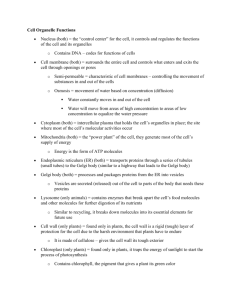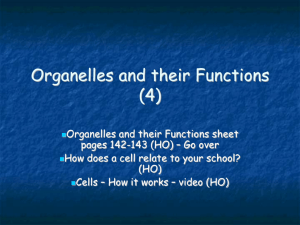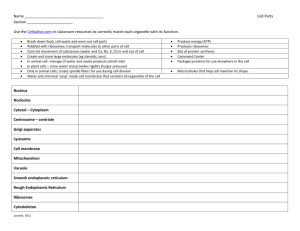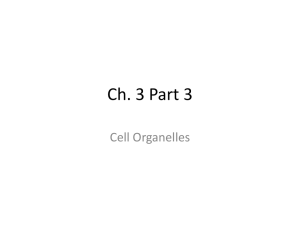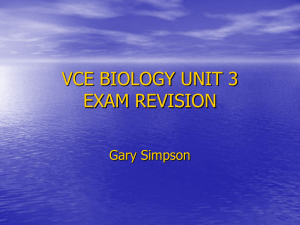11/5/14
advertisement
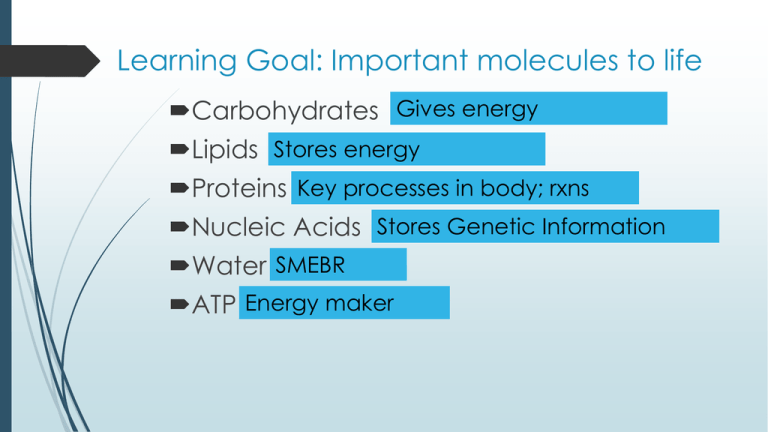
Learning Goal: Important molecules to life Carbohydrates Gives energy Lipids Stores energy Proteins Key processes in body; rxns Nucleic Acids Stores Genetic Information Water SMEBR ATP Energy maker SMEBR S = SOLVENT Water = universal solvent Key dissolver for ionic compounds (salts) and sugars, amino acids and proteins Transports ions in/out of cell https://www.youtube.com/watch?v=xdedxfhc pWo SMEBR M = Makes Bonds Polarity – uneven distribution of electrons Hydrogen bonds Not as strong Cohesion (same) Adhesion (different) SMEBR E = Environment 71% of Earth is water 60% human is water 3 days without water = death SMEBR B = Buffer for temperature Can absorb or contain heat In chemical reactions SMEBR R = Reactions Essential in chemical reactions Reactant or Product Photosynthesis Respiration Glycolysis (processing energy) Why is water so important? Recall with your neighbor what SMEBR stands for: Cell Theory – How did cells get discovered? Anton Van Leewenwook Robert Hooke The Wacky History of Cell Theory What are the 3 key ideas of cell theory? Cell Theory – How did cells get discovered? The Wacky History of Cell Theory What are the 3 key ideas of cell theory? 1. All organisms are composed 1 or more cells 2. Basic unit of organization for living things 3. All cells come from pre-existing cells Cell Organelles http://www.shellyssciencespot.co m/Worksheets/Cell/Organelles.pd f Two types: Prokaryotes Eukaryotes Bacteria, small organisms More complex organisms No nucleus Has a nucleus Eukaryotic Cells – Discuss with table to determine 3 similarities & 3 differences PLANT CELLS ANIMAL CELLS Cell Organelles Chapter 7.2 Eukaryotic Cells Cell Wall Only found surrounding plant, fungal and bacterial cells Made of cellulose It’s rigid and stiff Provides support and protection for the cell It’s like the wall that surrounds a city Cell Membrane Surrounds all cells In a plant cell, it’s beneath the cell wall In animal cells, it’s the outer boundary (made of cholesterol) Gives the cell Protection Controls the movement of material in/out of the cell Gives support Maintains conditions of the cell Similar to the border patrol of a country Nucleus Found in plant and animal cells Centrally located in the cell Controls cell activities Contains the genetic information (DNA) It’s like the control center Cytoplasm Found in all cells Clear, thick, gelatinous material Located beneath the cell membrane Supports and protects cell organelles Golgi Apparatus Found in plant and animal cells Looks like a flattened stack of membranes Processes and packages molecules such the carbon compounds to be transferred throughout the cell It’s similar to a Post Office Ribosomes Found in all cells Can be small individual molecules or attached to the E.R. Synthesizes proteins Smallest organelles It’s like the brick yard that supplies the city with the necessary materials needed Endoplasmic Reticulum Found in plant and animal cells Arrangement of a reticulum flattened sheets Transports materials throughout the cell Two types Smooth (no ribosomes) Rough (lined with ribosomes) It’s similar to a highway Mitochondria Found in plant and animal cells Football shaped with membranes within Breaks down sugar molecules to create ATP It’s similar to a power plant Vacuoles Found in plant and animal cells Plants: very large and only a few Animals: small and numerous Store food, water and waste It’s similar to a storage unit or warehouse Lysosomes Found in animal and some plant cells Small and round shaped Breaks down molecules to be used for other things Breaks down old cell parts It’s similar to a recycling center Chloroplasts Found in plant cells and some bacteria Oval shaped Green color due to the chlorophyll Takes in energy from the sun to create sugar that is processed as food It’s similar to solar panels on a building Quiz Yourself! Go to the following webpage to quiz yourself on the structures in the cell and the function: http://www.cellsalive.com/cells/cell_model.htm


